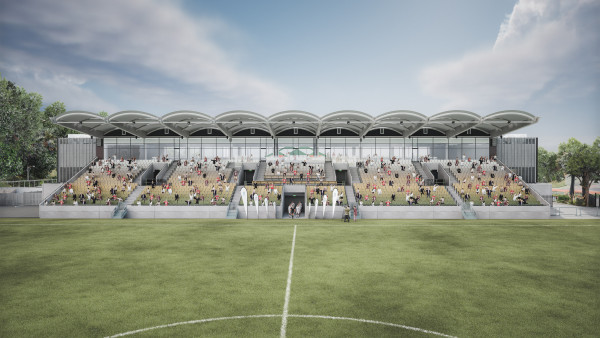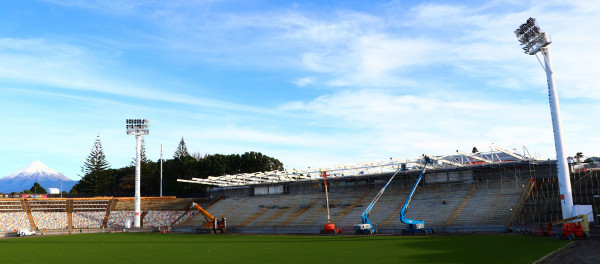Our vision: The best regional stadium in New Zealand that regularly hosts local, regional, national, and international sports and entertainment events.
Yarrow Stadium is being redeveloped to ensure its stands meet earthquake standards and the venue remains fit for purpose in the post-Covid era and a valued community asset.
The venue’s East and West grandstands were declared earthquake-prone and closed in 2017 and 2018. The repair and refurbishment project was approved in 2019 after we sought feedback from the community.
The repaired West Stand reopened in September 2022 while the East Stand is being rebuilt and is expected to open its doors to users for the 2025 winter sports season.
At a glance:
- The repaired West Stand reopened in 2022.
- The East Stand is being replaced and construction started in 2022 and is set to be completed by the 2025 winter sports season.
- The new East Stand has more space for conference and trade shows and flexibility to be used by visitors watching sport on the main pitch or outer fields.
- Local contractor Clelands Construction has been appointed to complete the $42m East Stand rebuild.
- The new hybrid pitch is more resilient and takes less time to recover after matches.
- Brighter and more eco-friendly LED lighting on the main pitch have replaced the old lighting which was beyond the end of its life.
Funding the project:
- Cost pressures and supply chain issues have increased the cost to build the East Stand.
- Additionally, the scope has changed as previously the TSB Stand was going to be repaired but that wasn’t possible because of poor ground conditions and insufficient foundation strength. That’s meant additional costs such as demolishing the TSB Stand, redesigning and building a new stand.
- The budget for the stadium redevelopment has moved from $70m to $79.7m.
- While the budget has increased, the total contributed by ratepayers remains under the $50m approved in 2019 as part of an extensive public consultation and engagement process.
- The Council secured $30 million in funding from the Government's Infrastructure Reference Group (IRG) programme which has limited the impact of rising construction costs on ratepayers
- The Yarrow Stadium targeted rate is not changing.
The East Stand project

We’ve demolished the old TSB Stand and are building a brand new stand in its place. We had originally sought feedback from our community about repairing it but had to make the decision to demolish and rebuild because of issues like poor ground conditions, the integration of the old structure and insufficient foundation strength.
What this means for our community it has created the opportunity to design a facility suitable for a wider range of uses including conferences, trade shows and other non-sport events, both public and private. The new stand offers much more flexibility for sports users as well as it is ‘double sided’ so visitors will be able to use it to watch rugby, football and other sports on both the main pitch and the outer fields.
The new stand’s facilities - the public toilets, changing rooms, showers and food/beverage areas - will be available to users of the outer fields without the need to open up the entire stand or rest of the stadium. The rebuilt stand will also have flexible and scalable seating capacity so it can cater for events and fixtures at all levels.
The new East Stand will also see the needs of the venue’s sports users accommodated under one roof. So there is now no longer the need for a stand-alone training centre incorporating community facilities and amenities, as originally planned.
We’ve worked closely with Ngāti Te Whiti on the new design of the East Stand and users will see this through the many cultural design elements in the new facility. This work has reconfirmed the strong links the Stadium has with the hapū.
The old stand was demolished in November 2021 and the new stand is set to be completed by 2024-2025.
The West Stand project

The West Stand (also known as the Noel & Melva Yarrow Stand) has been repaired and refurbished. It required major earthquake strengthening works, including improvements to ground stability, foundation tiebacks and new steel beams.
This involved the removal of all bleachers and seating to gain access to the ground below, as well as structural components. The work also included future-proofing the stand by replacing the old roof.
Visitors will notice the new roof but most of the repairs remain hidden under the stand now that it has reopened. The earthquake-strengthening project has included driving massive stabilisation piles into the ground in front of the stand and adding new structural steel beams to the stand itself.
Work started in December 2020 and has been undertaken during difficult construction conditions caused by the Covid-19 pandemic. The lead contractor is New Plymouth-based Clelands Construction.
Improved lighting and turf
The old lighting at the stadium was beyond the end of its life before the Yarrow Stadium project got underway so we’ve replaced it with new LED floodlights that are brighter and use less power.
The existing lights have been removed from the lighting towers and the new ones will be ready when the West Stand reopens in 2022. They will increase illuminance by 50% while reducing power consumption by 30%.
The LED floodlights were installed on the existing light towers and grandstand roofs by Arnold Jensen Electrical (AJE), a long-established Christchurch-based contractor, and Signify (formerly Philips Lighting).
The main pitch is also getting a much-needed makeover and is being replaced with ‘GrassMaster’ hybrid turf – a blend of natural turf grown through and among artificial fibre that give the pitch a longer life with shorter recovery times that can triple the amount of weekly playing time compared with conventional turf.
Hybrid turf is already in use at top venues including Auckland’s Eden Park and ASB Stadium, Hamilton’s FMG Stadium, Wellington’s Sky Stadium, Christchurch’s Orangetheory Stadium (formerly AMI Stadium) and Dunedin’s Forsyth Barr stadium.
GrassMaster hybrid turf offers a lifespan of up to 15 years and up to 1000 playing hours a year. It is used on more than 640 pitches worldwide including 80% of the UK’s Premier League clubs.
The turf will be ready for kick-off when the stadium reopens in 2022.
The contractor is Auckland-based FieldTurf, supported by design consultancy New Zealand Turf Management Solutions (NZTMS). FieldTurf has installed the GrassMaster product at Forsyth Barr Stadium, Orangetheory Stadium and FMG Stadium.
Project timeline
At a glance - progress so far |
||
|---|---|---|
| Project component | Current status | Expected completion |
| West Stand repair | Completed | 2022-23 |
| East Stand demolition | Completed | 2021 |
| New East Stand design | Stand design complete | 2022 |
| LED lighting upgrade |
Installed |
2022 |
| Main pitch upgrade | Completed | 2022 |
| New East Stand construction | 2022-2025 | |
Keep updated and connected
Anticipation is building about the reopening as people in Taranaki feel a deep connection to Yarrow Stadium.
Thousands of us have enjoyed countless big moments there over the years at popular events ranging from community celebrations to international and national sports fixtures including All Blacks games and even stunt motorcycle exhibitions.
With te maunga as a backdrop, it’s also an important window on the region for the rest of Aotearoa/New Zealand and the wider world.
You can keep up with stadium news on these pages or on the Yarrow Stadium Facebook page(external link)(external link).
We'll be holding regular briefings for near neighbours of the stadium, who can also sign up for neighbourhood newsletters(external link) about the project.
We're also working liaising with our Stadium partner, the New Plymouth District Council, as well as Sport Taranaki, sporting codes and other Stadium users, and iwi.